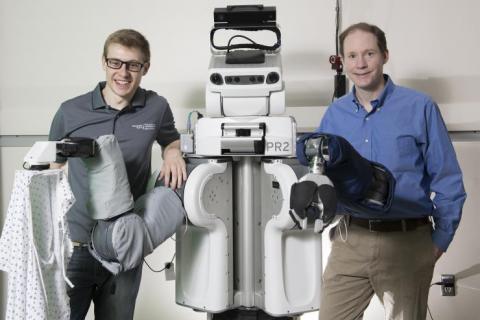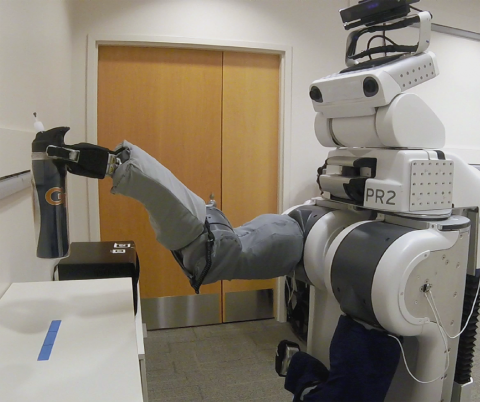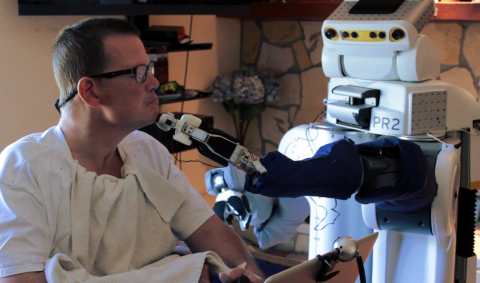Mobile Manipulator Robot
Principal Investigator
Charlie Kemp, Ph.D.
Team
Phillip Grice, Ari Kapusta, Daehyung Park, Yash Chitalia & Zackory Erickson
Partners
Henry and Jane Evans
Overview
For people with motor impairments due to an injury, stroke or chronic condition (e.g., Parkinson’s disease), the ability to manipulate tools to perform basic activities of daily living, such as brushing teeth or using a spoon to eat, can become severely limited with age. To carry out these essential activities, many of these individuals require extensive caregiving support, which can be physically, emotionally and financially taxing on themselves and their families. In this project, we developed an interactive robotic system to provide physical assistance to people with severe motor impairments.
The system features a PR2 robot, equipped with wheels for driving and two arms with grippers that allow for grasping objects and interacting with people. Collaborating with Henry Evans, a stroke survivor with quadriplegia, we designed a web interface that enabled him to control this robot to successfully perform certain everyday tasks, such as shaving and feeding, without the assistance of a human caregiver. Moreover, testing of the web interfaces among other people with severe upper body impairments revealed that users can control this robot to perform everyday object manipulation tasks, with a clinically significant improvement beyond their personal capabilities.
We demonstrated that the robot can provide assistance with dressing tasks such as putting on a hospital gown or sweater. The robot is able to sense human movement during dressing, and is capable of providing personalized assistance by learning and adapting to a person’s specific impairments. Finally, we roboticized a standard hospital bed, known as Autobed, that can estimate the 3D pose of a person on the bed using a pressure-sensing mat. Together, Autobed and the mobile robot collaborate as a system to better accomplish assistive tasks for a person lying in bed, such as feeding, scratching an itch, bed bathing, or pulling sheets on or off the person. Key words: Assistive robotics, Healthcare, Mobile Manipulator, Robot-Assisted Feeding, Robot-Assisted Dressing, Teleoperation, Human-Robot Interaction



In the News
- Georgia Tech Research Horizons (2019, March). Research by Investigator Charlie Kemp and Phil Grice featured in news story, “Seeing through a Robot’s Eyes Helps Those with Profound Motor Impairments”.
- Georgia Tech News Center (2018, May). Research by Investigator Charlie Kemp featured in news story, “Robot Teaches Itself How to Dress People”.
- TED Talk (TEDxMidAtlantic, 2013, October). Henry Evans & Chad Jenkins: Meet the Robots for Humanity.
Technology Products
Autobed – Web controlled electric hospital bed (Charlie Kemp, Healthcare Robotics Lab). The Autobed module is an additional module for an Invacare fully electric hospital bed (Model 5410IVC) so that the bed can be controlled from a web-based interface. This module can be easily plugged between the hand control and the Invacare bed, without having to modify any existing hardware on the bed. The Autobed technology gives the control of an electric bed to the motor impaired bedridden person. This enables any motor impaired person who can operate a web browser to control their own electric bed at a very low cost. Invacare, Co. is currently working on commercializing Autobed.
Select Publications
Park, D., Hoshi, Y., Mahajan H. P., Kim, H. K., Erickson, Z., Rogers, W. A., & Kemp, C. C. (2020). Active robot-assisted feeding with a general-purpose mobile manipulator: Design, evaluation, and lessons learned. Robotics and Autonomous Systems. https://doi.org/10.1016/j.robot.2019.103344
Kapusta A., Erickson, Z., Clever, H.M., Yu, W., Liu, K., Turk, G., & Kemp, C. C. (2019). Personalized collaborative plans for robot-assisted dressing via optimization and simulation. Autonomous Robots. https://doi.org/10.1007/s10514-019-09865-0
Kapusta, A. S., Grice, P. M., Clever, H. M., Chitalia, Y., Park, D. & Kemp, C. C. (2019). A system for bedside assistance that integrates a robotic bed and a mobile manipulator. PLOS ONE, 14(10), https://doi.org/10.1371/journal.pone.0221854
Grice, P. M. & Kemp, C. C. (2019). In-home and remote use of robotic body surrogates by people with profound motor deficits. PLOS ONE, 14(3): e0212904. https://doi.org/10.1371/journal.pone.0212904
Erickson, Z., Collier, M., Kapusta, A. & Kemp, C. C. (2018) Tracking human pose during robot-assisted dressing using single-axis capacitive proximity sensing. IEEE Robotics and Automation Letters, 3(3) 2245-52. https://doi.org/10.1109/LRA.2018.2812912
Park, D., Kim, H., & Kemp, C. C. (2018). Multimodal anomaly detection for assistive robots. Autonomous Robots. https://doi.org/10.1007/s10514-018-9733-6
Bhattacharjee, T., Clever, H. M., Wade, J. & Kemp, C. C. (2018). Multimodal tactile perception of objects in a real home. IEEE Robotics and Automation Letters, 3(3), 2523-2530. https://doi.org/10.1109/LRA.2018.2810956
Wade, J., Bhattacharjee, T., Williams, R. D., & Kemp, C. C. (2017). A force and thermal sensing skin for robots in human environments. Robotics and Autonomous Systems, 96, 1-14. https://doi.org/10.1016/j.robot.2017.06.008
